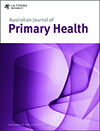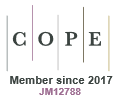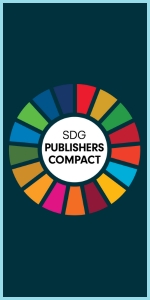Australian Journal of Primary Health
Volume 31
Number 3 2025
Inaccessibility of primary healthcare services in rural and remote communities is argued to lead to higher rates of potentially preventable hospitalisations. This research aimed to develop an explanatory method that could be applied for investigating settings considered high risk for potentially preventable hospitalisations. This method provides a structured and detailed six-step plan for examining identified regions; providing an understanding of the access pathways to primary healthcare services, and identifying where interventions and prevention strategies would support equitable healthcare access.
This systematic review synthesises research examining the experiences of fathers and non-birth parents using child and family health services. It identifies facilitators and barriers to father- and non-birth parent-inclusive practice and strategies used by child and family health nurses and other healthcare practitioners to improve engagement with them.
Patient health navigators have an emerging role in assisting people to connect with health and social care especially those experiencing language and communication barriers. A challenge is sustaining navigator programs’ implementation. This study demonstrates the potential role of bilingual community navigators in providing navigation assistance to culturally and linguistically diverse patients in general practice. More effort is needed to tailor attachments to the unique needs of the patient population and practice schedule. Sustainability requires ongoing funding and broad institutional support.
The impacts of acquired hearing loss on health are relatively unknown in the community and often in the medical profession, and referral rates from general practice to audiology are low. We designed a theory-informed questionnaire to explore the barriers and enablers affecting general practitioners’ referral behaviours and identified 10 important barriers and/or enablers, including eight barriers/enablers not previously documented in the literature. These findings will contribute to the design of behavioural interventions to increase general practitioner referral rates to audiology.
Domestic violence and abuse impacts one-third of women globally, and greatly affects women’s health and wellbeing. Migrant/refugee women are at greater risk of domestic violence and abuse, and experience additional barriers to accessing support compared with non-migrant/refugee women. The HARMONY study was a randomised controlled trial that included delivering culturally safe domestic violence training to general practices. The training aimed to enhance culturally safe practices when supporting women identified as experiencing domestic violence.
This article belongs to the collection: Quality Improvement and Evaluation in Primary Health Care.
Global and national increases in syphilis infection, particularly amongst women of reproductive age, constitute a public health emergency. Those populations experiencing adverse social determinants are at higher risk. To address this, a pilot was implemented for delivering syphilis rapid testing through street-based nursing outreach programs serving the homeless. The results of this pilot demonstrated the challenges and successes for a street-based syphilis testing service and how it might become integrated into routine care.
This article belongs to the collection: Quality Improvement and Evaluation in Primary Health Care.
Implementing tuberculosis (TB) infection prevention and control guidelines can be ineffective in resource-constrained primary healthcare facilities. Yet, there is little agreement on what strategies are most important for effective TB infection prevention and control practices. It is, therefore, crucial to learn from healthcare workers employed in TB control programs about the important strategies to improve the implementation of TB- infection prevention and control guidelines.
Cancer survivors in Australia often face ongoing physical, emotional, and practical challenges, yet their supportive care needs are not consistently met in general practice. This study highlights key barriers for general practitioners and nurses, including limited time, lack of clear processes, and poor communication between healthcare providers, while identifying solutions such as better training, improved information sharing, and greater support for nurses. Strengthening these areas could enhance care, improving quality of life and long-term health outcomes for cancer survivors.
The Aboriginal community controlled health organisation sector in Australia emerged from social movements for Aboriginal self-determination before the Declaration of the Alma Ata, developing a model of community health that was community led, provided holistic care and took action on social determinants of health. Our findings from interviews with community health actors since the 1970s documented these strengths, and how they influenced generalist community health. The sector remains a strong example of community health relevant to all Australians.
This article belongs to the collection: Models of Community Health in Action.





